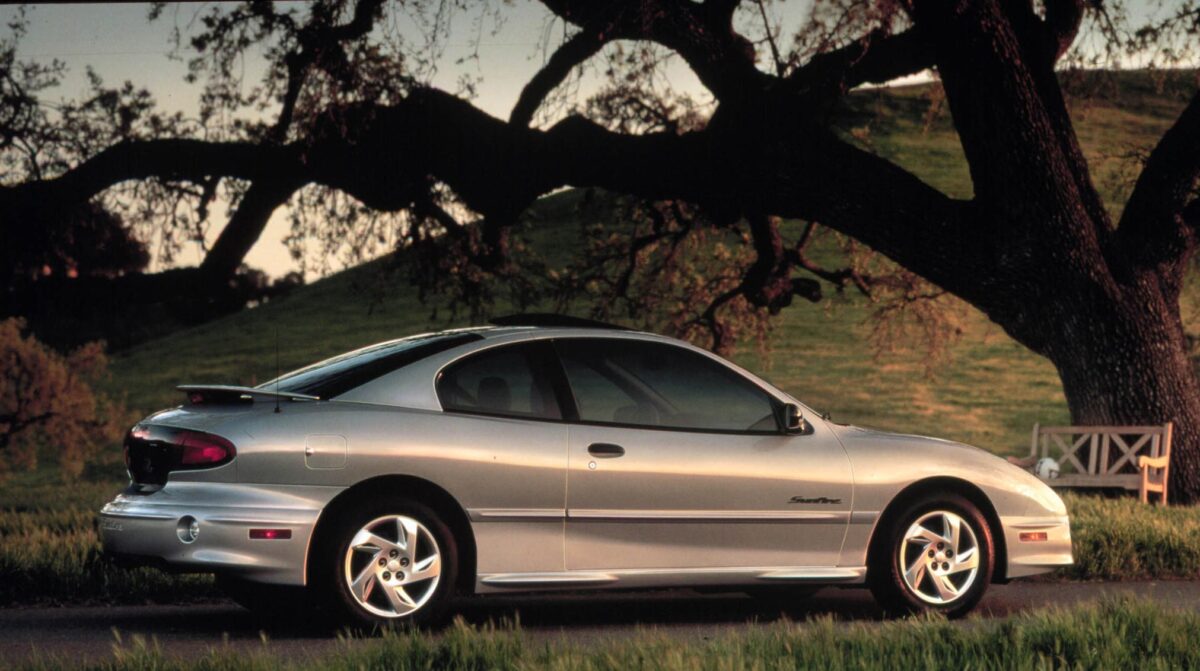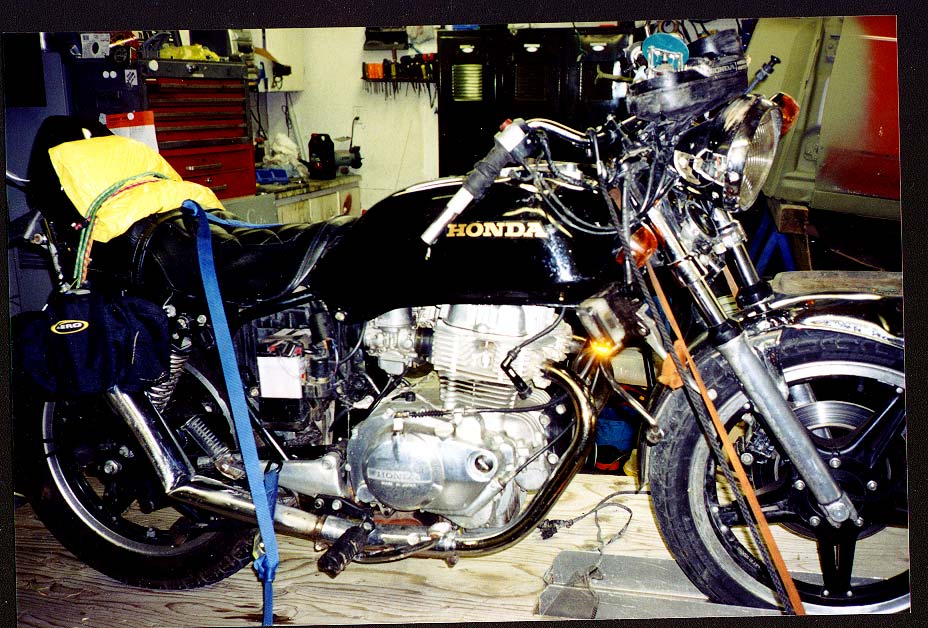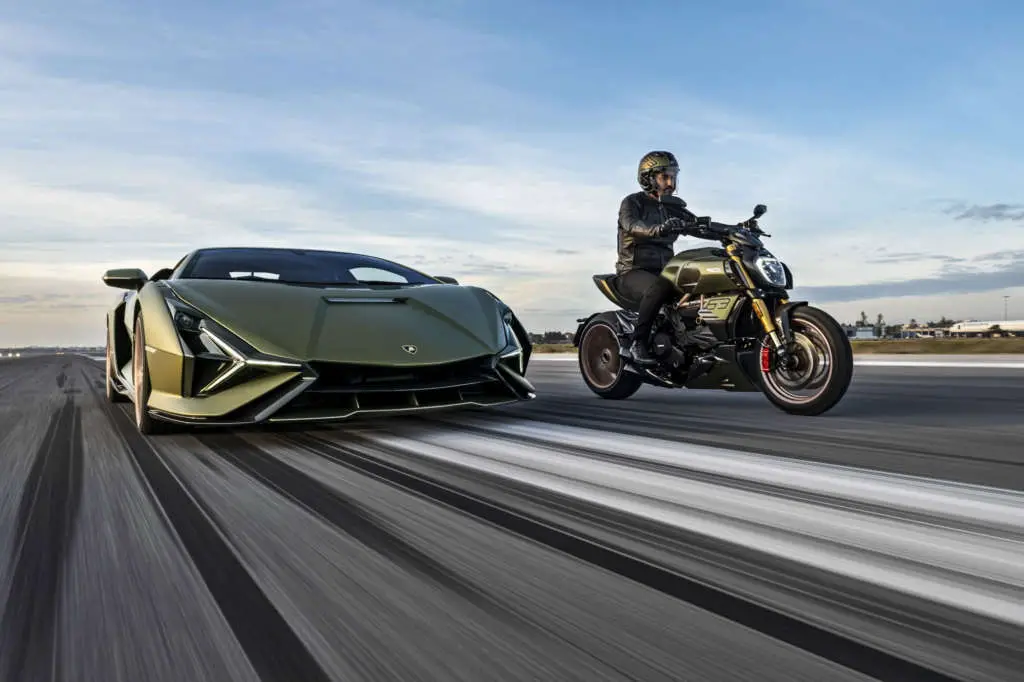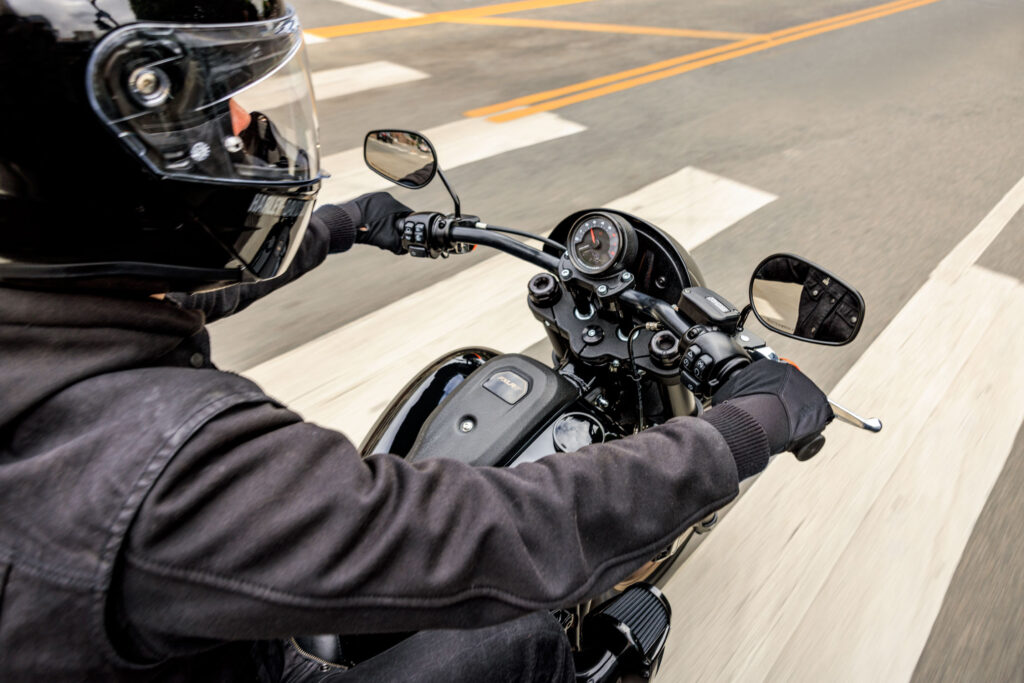
Section Nine: Survivability – Cars Versus Motorcycles
Cars are bigger, heavier, make of more metal, hit harder, have no brains and simply do not play fair. Cars versus motorcycles, an automatic defeat? Maybe not…
The purpose of this article is NOT to scare you, or shove statistics down your throat either. It is to show you what works and what doesn’t work in a brief way so you can increase you chance of riding away unharmed. If you want to read more about improving your riding skills, I highly suggest: Proficient Motorcycling by David L. Hough.
Motorcycles have advantages over cars (and other vehicles) that when realized (used and practiced) can even up the odds of NOT getting into an accident. A car’s weight is just too much for a motorcycle to come out on top. 55% of all U.S. motorcycle fatalities involved a collision between a motorcycle and another vehicle, here are some facts:
| Collision Between |
Other Vehicle
|
Motorcyclist
|
| Car & Motorcycle |
17
|
596
|
| Light truck & Motorcycle |
0
|
396
|
| Large truck & Motorcycle |
0
|
114
|
| Motorcycle & Motorcycle |
n/a
|
28
|
| Bus & Motorcycle |
0
|
7
|
| Other/unknown & Motorcycle |
0
|
29
|
|
from Bureau of Transportation Statistics, U.S. Fatalities, Two-vehicle Collisions, 1994
|
||
Sickening statistics eh? I used these above statistics to prove one point. Don’t hit another vehicle* because chances are you won’t win. (* or other stationary object: poll, building, etc.) “When they meet, four wheels are frequently better than two. While the car’s driver is usually uninjured, the cyclist needs transportation to the hospital.”
So, what can we do as motorcyclists so we do not end up in this situation? Since you don’t want you hurt, injured or dead here is what YOU can do about it.
Survivability – Cars Versus Motorcycles
Motorcycles are small, lightweight, performance oriented motorized vehicles compared to other vehicles. This gives them certain advantages and disadvantages on the road in an emergency situation.
We have already looked at 1 of the major disadvantages of the motorcycle, and that is hitting something bigger and heavier than you. The Solution: Don’t. Simply, Don’t hit it and do everything you can to avoid hitting it. Sure that sounds easy and I can see you laughing that that. If you hit something there wasn’t anything you could do to avoid it in the first place, that’s why you hit it… or was there something you could do?
That’s is THE question, did you know and practice your motorcycles advantages and know what to do? Did you use all your advantages or not?
The Advantages of a Motorcycle (over other vehicles):
A famous motorcycle expression goes something like this: “There are two kinds of bikers, those who have been in an accident, and those about to be”. Don’t think of “accident” as fatal, injuring, death in your face type because it means any type of accident like dropping your bike on your driveway or at an intersection. There are no substitutes for learning than experience. Experience comes from making mistakes and learning from them. So, accept that you are going to make a mistake, it is natural, and OK.
I’ve been in 2 accidents. The first one was the wind blowing over my bike on top of a hill while on its center stand (in the middle of no where). Minor accident but I learned from it (don’t park your bike on soft soil when it is really windy out and lucky I knew how to pick up a 500+lb motorcycle myself). The second one was taking a curve too fast on the highway for my skill level riding in a competitive group. Sure I regret the major accident and the loss of my motorcycle, but again, I learned a lot from it. I walked away with only minor injuries (sprained wrist) but learned important lessons as well like: Don’t get caught up in a group mentality, always watch for blind curves, slow down when you are not 100% certain of the road ahead, slow down for corners plus more. Sure I knew all that stuff from my Motorcycle Safety Foundation course but I could not recall it immediately when I needed it. That is where practice comes in, over and over again. You will always do what comes naturally and you are in the habit of doing.
The Advantages of a Motorcycle vs Car:
In case you do not know, a motorcycle has really good acceleration, braking and maneuverability over other vehicles. How good? Let’s take an average motorcycle and car:
2008 Suzuki GS500E.

Engine Size: 487 cc
Horse Power (HP): 39.2 @ 8500
Torque: 26.6 @ 7000
1/4 Mile: 13.65 sec @ 95.5mph
Braking (60mph, 100-0 km/hr) approx.: 36-42 meters (120 – 140 feet)
Weight: 424lbs
This is a good typical first or second motorcycle. 39hp doesn’t sound like a lot does it since a typical car stacks up like this:
2003 Pontiac Sunfire

Engine Size: 2198 cc
Horse Power (HP): 140 @ 5600
Torque: 150 @ 4000
1/4 Mile: 16.9 sec @ 78 mph
Braking (60mph, 100-0 km/hr) 50.4 meters (165.35feet)
Weight: 2,771lbs
So the car on the other hand has 100hp, 123 foot lbs more torque and weights 2,347 more than the GS500E.
BUT, you can out accelerate it, out brake it and out maneuver it in tight spots. Even an old GS500E with 26hp can do it so a 2024 Motorcycle sure can!
A Suzuki GSXR 1100 has great acceleration. You’ll be at 100 mph in under 3 seconds. You can hit 150 without trying too hard. Just remember that the peace officer’s radio can always call ahead faster than you can outrun him.
Late Evening Reads
Required Reading for all Motorcyclists, What You Don’t Know Can Hurt You.
“The Hurt Report”
(AKA “Motorcycle Accident Cause Factors and Identification of Countermeasures”)
A brief summary of the findings is listed below. To order the full report, contact: National Technical Information Service
5285 Port Royal Road, Springfield, Virginia 22161, (703)-487-4600 and order:
Motorcycle Accident Cause Factors and Identification of Countermeasures, Volume 1: Technical Report, Hurt, H.H., Ouellet, J.V. and Thom, D.R., Traffic Safety Center, University of Southern California, Los Angeles, California 90007, Contract No. DOT HS-5-01160, January 1981 (Final Report), Vol.I (The Main Report and Summary) is PB81206443 (~400 pages), Vol.II (Appendix: Supplementary Data) is PB81206450 (~400 pages)
Summary of Findings
Throughout the accident and exposure data there are special observations which relate to accident and injury causation and characteristics of the motorcycle accidents studied. These findings are summarized as follows:
1. Approximately three-fourths of these motorcycle accidents involved collision with another vehicle, which was most often a passenger automobile.
2. Approximately one-fourth of these motorcycle accidents were single vehicle accidents involving the motorcycle colliding with the roadway or some fixed object in the environment.
3. Vehicle failure accounted for less than 3% of these motorcycle accidents, and most of those were single vehicle accidents where control was lost due to a puncture flat.
4. In single vehicle accidents, motorcycle rider error was present as the accident precipitating factor in about two-thirds of the cases, with the typical error being a slide out and fall due to over braking or running wide on a curve due to excess speed or under-cornering.
5. Roadway defects (pavement ridges, potholes, etc.) were the accident cause in 2% of the accidents; animal involvement was 1% of the accidents.
6. In multiple vehicle accidents, the driver of the other vehicle violated the motorcycle right-of-way and caused the accident in two-thirds of those accidents.
7. The failure of motorists to detect and recognize motorcycles in traffic is the predominating cause of motorcycle accidents. The driver of the other vehicle involved in collision with the motorcycle did not see the motorcycle before the collision, or did not see the motorcycle until too late to avoid the collision.
8. Deliberate hostile action by a motorist against a motorcycle rider is a rare accident cause. The most frequent accident configuration is the motorcycle proceeding straight then the automobile makes a left turn in front of the oncoming motorcycle.
10. Intersections are the most likely place for the motorcycle accident, with the other vehicle violating the motorcycle right-of-way, and often violating traffic controls.
11. Weather is not a factor in 98% of motorcycle accidents.
12. Most motorcycle accidents involve a short trip associated with shopping, errands, friends, entertainment or recreation, and the accident is likely to happen in a very short time close to the trip origin.
13. The view of the motorcycle or the other vehicle involved in the accident is limited by glare or obstructed by other vehicles in almost half of the multiple vehicle accidents.
14. Conspicuity of the motorcycle is a critical factor in the multiple vehicle accidents, and accident involvement is significantly reduced by the use of motorcycle headlamps (on in daylight) and the wearing of high visibility yellow, orange or bright red jackets.
15. Fuel system leaks and spills were present in 62% of the motorcycle accidents in the post-crash phase. This represents an undue hazard for fire.
16. The median pre-crash speed was 29.8 mph, and the median crash speed was 21.5 mph, and the one-in-a-thousand crash speed is approximately 86 mph.
17. The typical motorcycle pre-crash lines-of-sight to the traffic hazard portray no contribution of the limits of peripheral vision; more than three-fourths of all accident hazards are within 45deg of either side of straight ahead.
18. Conspicuity of the motorcycle is most critical for the frontal surfaces of the motorcycle and rider.
19. Vehicle defects related to accident causation are rare and likely to be due to deficient or defective maintenance.
20. Motorcycle riders between the ages of 16 and 24 are significantly overrepresented in accidents; motorcycle riders between the ages of 30 and 50 are significantly underrepresented. Although the majority of the accident-involved motorcycle riders are male (96%), the female motorcycles riders are significantly overrepresented in the accident data.
22. Craftsmen, laborers, and students comprise most of the accident-involved motorcycle riders. Professionals, sales workers, and craftsmen are underrepresented and laborers, students and unemployed are overrepresented in the accidents.
23. Motorcycle riders with previous recent traffic citations and accidents are overrepresented in the accident data.
24. The motorcycle riders involved in accidents are essentially without training; 92% were self-taught or learned from family or friends. Motorcycle rider training experience reduces accident involvement and is related to reduced injuries in the event of accidents.
25. More than half of the accident-involved motorcycle riders had less than 5 months experience on the accident motorcycle, although the total street riding experience was almost 3 years. Motorcycle riders with dirt bike experience are significantly underrepresented in the accident data.
26. Lack of attention to the driving task is a common factor for the motorcyclist in an accident.
27. Almost half of the fatal accidents show alcohol involvement.
28. Motorcycle riders in these accidents showed significant collision avoidance problems. Most riders would overbrake and skid the rear wheel, and underbrake the front wheel greatly reducing collision avoidance deceleration. The ability to countersteer and swerve was essentially absent.
29. The typical motorcycle accident allows the motorcyclist just less than 2 seconds to complete all collision avoidance action.
30. Passenger-carrying motorcycles are not overrepresented in the accident area.
31. The driver of the other vehicles involved in collision with the motorcycle are not distinguished from other accident populations except that the ages of 20 to 29, and beyond 65 are overrepresented. Also, these drivers are generally unfamiliar with motorcycles.
32. Large displacement motorcycles are underrepresented in accidents but they are associated with higher injury severity when involved in accidents.
33. Any effect of motorcycle color on accident involvement is not determinable from these data, but is expected to be insignificant because the frontal surfaces are most often presented to the other vehicle involved in the collision.
34. Motorcycles equipped with fairings and windshields are underrepresented in accidents, most likely because of the contribution to conspicuity and the association with more experienced and trained riders.
35. Motorcycle riders in these accidents were significantly without motorcycle license, without any license, or with license revoked.
36. Motorcycle modifications such as those associated with the semi-chopper or cafe racer are definitely overrepresented in accidents.
37. The likelihood of injury is extremely high in these motorcycle accidents-98% of the multiple vehicle collisions and 96% of the single vehicle accidents resulted in some kind of injury to the motorcycle rider; 45% resulted in more than a minor injury.
38. Half of the injuries to the somatic regions were to the ankle-foot, lower leg, knee, and thigh-upper leg.
39. Crash bars are not an effective injury countermeasure; the reduction of injury to the ankle-foot is balanced by increase of injury to the thigh-upper leg, knee, and lower leg.
40. The use of heavy boots, jacket, gloves, etc., is effective in preventing or reducing abrasions and lacerations, which are frequent but rarely severe injuries.
41. Groin injuries were sustained by the motorcyclist in at least 13% of the accidents, which typified by multiple vehicle collision in frontal impact at higher than average speed.
42. Injury severity increases with speed, alcohol involvement and motorcycle size.
43. Seventy-three percent of the accident-involved motorcycle riders used no eye protection, and it is likely that the wind on the unprotected eyes contributed in impairment of vision which delayed hazard detection.
44. Approximately 50% of the motorcycle riders in traffic were using safety helmets but only 40% of the accident-involved motorcycle riders were wearing helmets at the time of the accident.
45. Voluntary safety helmet use by those accident-involved motorcycle riders was lowest for untrained, uneducated, young motorcycle riders on hot days and short trips.
46. The most deadly injuries to the accident victims were injuries to the chest and head.
47. The use of the safety helmet is the single critical factor in the prevention of reduction of head injury; the safety helmet which complies with FMVSS 218 is a significantly effective injury countermeasure.
48. Safety helmet use caused no attenuation of critical traffic sounds, no limitation of precrash visual field, and no fatigue or loss of attention; no element of accident causation was related to helmet use.
49. FMVSS 218 provides a high level of protection in traffic accidents, and needs modification only to increase coverage at the back of the head and demonstrate impact protection of the front of full facial coverage helmets, and insure all adult sizes for traffic use are covered by the standard.
50. Helmeted riders and passengers showed significantly lower head and neck injury for all types of injury, at all levels of injury severity.
51. The increased coverage of the full facial coverage helmet increases protection, and significantly reduces face injuries.
52. There is no liability for neck injury by wearing a safety helmet; helmeted riders had less neck injuries than unhelmeted riders. Only four minor injuries were attributable to helmet use, and in each case the helmet prevented possible critical or fatal head injury.
53. Sixty percent of the motorcyclists were not wearing safety helmets at the time of the accident. Of this group, 26% said they did not wear helmets because they were uncomfortable and inconvenient, and 53% simply had no expectation of accident involvement.
54. Valid motorcycle exposure data can be obtained only from collection at the traffic site. Motor vehicle or driver license data presents information which is completely unrelated to actual use.
55. Less than 10% of the motorcycle riders involved in these accidents had insurance of any kind to provide medical care or replace property.
LOSING A STUDENT: Motorcycle safety instructor deals with trainee’s death
Just a few weeks ago, I caught word that one of my former motorcycle safety course students had died … killed on his motorcycle.
I’ve been teaching motorcycle safety for a couple of years now and had gotten comfortable reciting accident statistics. After all, they were only numbers — data to be sorted by researchers. Suddenly the statistics had a name, a face and a circle of friends who were mourning his death.
The news ate at my soul as I recounted everything I had said and done in that class. What had gone wrong? Was it a mechanical problem? Did a car run him off the road? Was it a fluke that couldn’t have been prevented? The questions ran through my mind in a continuous stream. Each question I asked myself spawned two more that I couldn’t yet answer.
I went to the scene of the crash and heard the facts from the first responders. As the story unfolded, it became evident that none of the usual suspects were to blame. I couldn’t help but think about how senseless it all was.
The next question I asked myself was one I couldn’t let go. Was this an off-chance occurrence or was it the latest in a long series of similar tragedies?
I went back to the Air Education and Training Command safety office and asked for all the information they had on motorcycle fatalities going as far back as they had records. They patiently endured my morbid request and read the details of every Class A motorcycle incident in the command since 1981. The records told the stories of tragic accidents and insane behaviors that had led to the deaths of 46 members of my Air Force.
I poured through my notes picking out the causal factors for each crash and trying to see if there were any common factors. I’m no Harry Hurt*, and I’m not a trained accident investigator, but maybe there was something that the untrained eye could notice. I started with the obvious choices like speeding, alcohol, and those known in the motorcycling community to be the perennial favorites —running wide in a turn, and the car that turns left in front of you at an intersection.
While all of these culprits were represented in the numbers, there was no single, major contributor I could point to and say, “If we could just eliminate this one factor…”
It wasn’t until I went back and read all the histories of all the deaths again that I heard myself saying, “What was this guy thinking?” over and over again.
There it was; the common element that showed up far too often in the statistics had been there all along. It was so subtle that I had difficulty picking it out of the glaring tragedies that were before me. In the majority of these crashes, the rider exercised poor judgment and paid for it with his life.
Judgment errors were a contributing factor in at least 63 percent of the motorcycle deaths in AETC since we began keeping records. Now if you’re saying that this seems to be an incredibly broad area into which all kinds of behaviors can be grouped, you’re right. However, it’s not too broad for an objective look at the subject.
The choices we make as riders reflect our attitude toward motorcycling. Exhibits of poor judgment — such as riding a motorcycle while drunk, or riding beyond the limits of machines, the road or your own abilities — reflect your attitudes toward motorcycling. So does riding responsibly, riding in control and riding within your limits.
As with so many aspects of life, attitude is everything.
Can we actually do anything to affect the attitudes riders have in AETC? I remember one of the questions from my first set of career development courses asking, “What was the purpose of the Air Force safety program?” The answer always intrigued me: “To develop a safety-minded attitude.”
Attitudes are strange “creatures.” We adopt them from someone, we refine and develop them, and we pass them on to others. As the old adage says, “Attitudes are caught, not taught.” We caught our attitudes about motorcycling from someone, and these became the basis for our own. Hopefully, the attitudes we’ve caught and developed are those that value safety.
I’m writing to the “older and wiser” riders, like myself, who got that way because, by the grace of God, we survived our “younger and foolish days.” All who read this can probably think back to a time when we narrowly escaped becoming a statistic ourselves. Do you remember what it was like being 23 and bulletproof? Think of all of the valuable lessons we could pass on to the next generation of wannabe older-and-wiser riders.
For those new to the sport, a few pieces of sage advice. First, know your limits and ride within them. Second, don’t hang around stupid people. They’ll only get you into trouble. Third, the single most important piece of safety equipment you own is the one you put inside your helmet.
I wrote this article because an error in judgment started a lethal chain of events that cost an airman his life (he popped a wheelie in a parking lot and ran into a brick wall). I can only speculate as to why he chose to pull the front wheel off the ground, or what caused him to lose control. But I know that in a few short seconds, in a momentary lapse of prudence, he cast aside riding within his limits. His actions outstripped his ability to ride with control, and he exceeded the safe limits of his environment.
He paid the ultimate price for a momentary lack of judgment. I can’t pass judgment on his actions because, like many of you, I can recall myself bypassing good judgment only to later mutter, “What was I thinking?” Like the rest of you who have survived your youth, my charge is to pass this “wisdom” on to the next generation of riders. Trend lines and statistical analysis can’t bring back the lives of those who have died.
We motorcyclists need to take care of our own. This begins with ensuring that troops get the required Motorcycle Safety Foundation training, but we can’t stop there. It takes more than a one-day or three-day course to make safe attitudes take root. We all must take responsibility for mentoring our fellow riders before they become statistics.
Sergeant Ellis is with the 332nd Training Squadron at Keesler Air Force Base, Miss. He is a motorcycle safety instructor. He is also his squadron’s motorcycle safety coordinator. He has been riding motorcycles since 1981. *Harry Hurt is the author of Motorcycle Accident Cause Factors and Identification of Countermeasures a study conducted by the University of Southern California. He investigated almost every aspect of 900 motorcycle accidents in the Los Angeles area. Additionally, Hurt and his staff analyzed 3,600 motorcycle traffic accident reports in the same geographic area.
Hard Knocks: A few drinks, no helmet land motorcyclist in emergency room
May 9 started off innocently enough. My friend Dave and I had made arrangements to do some work on his Harley-Davidson Wide Glide. After working on the bike and fixing the problem, we decided to go for an evening ride with some other friends downtown. We stopped for pizza, a few drinks and took in a play.
At about 11:30 p.m., Dave and I decided to call it a night and returned to our bikes to head for home. I followed Dave, who was riding 20 to 30 yards ahead of me. My last memory before the accident was as if time stopped. Everything was in black and white, and I saw a street curb directly in front of my Harley-Davidson Sportster.
Before impact, I thought, “This is going to hurt.” But I also believed I’d be OK.
I came to in the back of a University of Arkansas Medical School ambulance on the way to the hospital. The emergency medical technicians were cutting my clothes off with scissors. Suddenly, I was unconscious again.
The second time I awoke, I was on my back in the emergency room with a brace around my neck, a white sheet over my body and in pain like I’d never felt before. I had road rash on both arms, legs and on the small of my back. I had a three-inch cut on my forehead, a two-inch cut on the top of my head, and my right ear was nearly ripped off.
I hadn’t worn a helmet.
All of my head wounds needed stitches or staples. At the time I still was unsure how badly I’d hurt myself. As I laid in the ER while the doctors worked on me, I never felt so alone and scared in my life. My wife and son were out of town visiting her family.
I couldn’t believe what I’d done to myself.
I prided myself on being an excellent motorcyclist. But during the days of my recovery, I realized that it didn’t matter how well I could ride a motorcycle. If I had no self-control, I was bound to hurt myself and those around me. I knew if I were to ever get back on a motorcycle, I had a lot of growing up to do.
I know that riding impaired and not riding with the proper protective equipment is dangerous and is the quickest way to personal injury and death. I’m extremely lucky to be alive today to share my story.
I wish that I could turn back the clock and do things differently, but I can’t. I can only beg those that I come in contact with to learn from my mistakes. Be responsible, and use good judgment and self-control. If you’re not in sound mind and body, you shouldn’t be in a car or on a motorcycle.
— Staff Sgt. Eric D. Folks
Little Rock Air Force Base, Ark.










